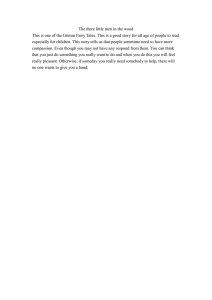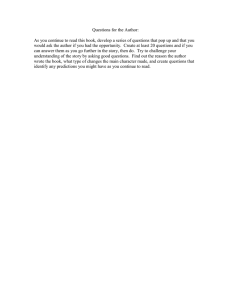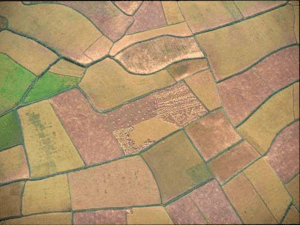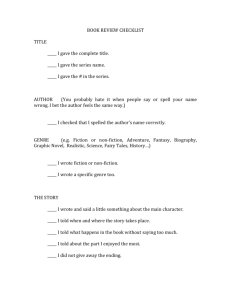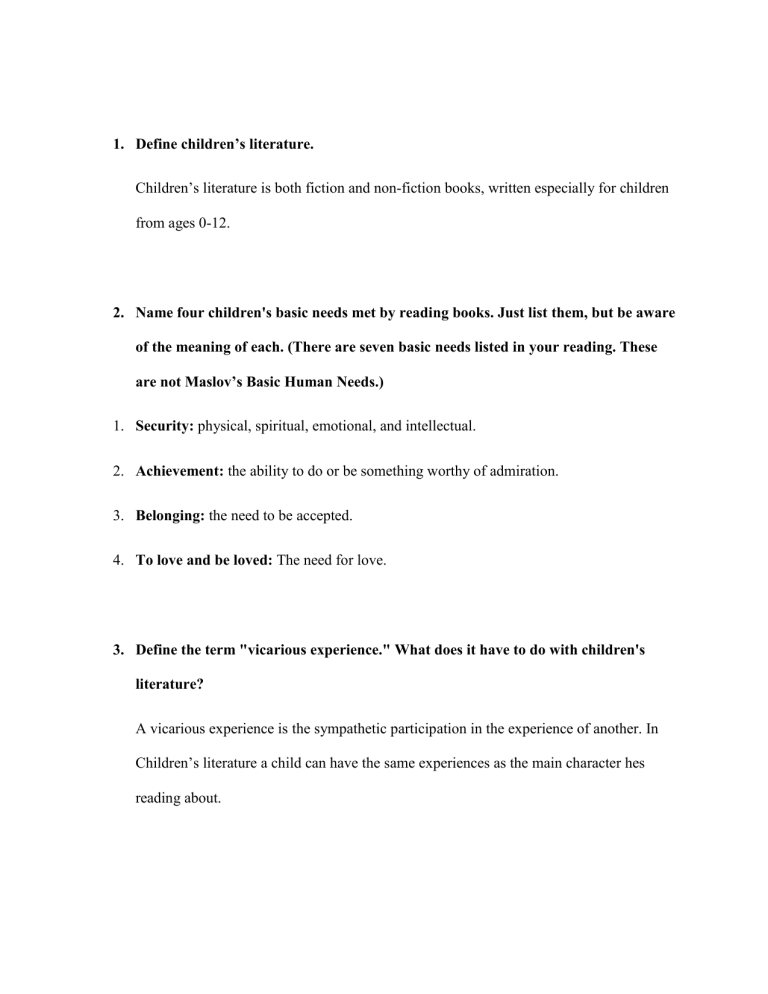
1. Define children’s literature.
Children’s literature is both fiction and non-fiction books, written especially for children
from ages 0-12.
2. Name four children's basic needs met by reading books. Just list them, but be aware
of the meaning of each. (There are seven basic needs listed in your reading. These
are not Maslov’s Basic Human Needs.)
1. Security: physical, spiritual, emotional, and intellectual.
2. Achievement: the ability to do or be something worthy of admiration.
3. Belonging: the need to be accepted.
4. To love and be loved: The need for love.
3. Define the term "vicarious experience." What does it have to do with children's
literature?
A vicarious experience is the sympathetic participation in the experience of another. In
Children’s literature a child can have the same experiences as the main character hes
reading about.
4. What are the qualities of a good story? (There are four you can find in your
reading.)
The qualities of a good story are, Lively action and plot, Worthwhile theme or message,
unique memorable character, style that reads aloud delightfully.
5. What values are gained from literature? (Note I said "literature," which denotes
quality. I did not say just books. Three values are listed in the class notes.)
The values gained from literature are, the first value is insight into living which mean,
learning how others live and view the world. The second value lived is reverence for life,
which means respect the life, culture, and religion of others. The third value is zest for
life, that means a deep appreciation for all aspects of life, whether they are adventurous
and exciting, sad and scary or dull and boring.
6. Describe what constitutes a Caldecott Award-winning book.
The criteria for a Caldecott award winning book is the best artwork or illustrations in a
children’s book from the previous year.
7. Give an example of a Caldecott Winner (title and author).
2019 medal winner, Hello lighthouse, illustrated and written by Sophia Blackall.
8. Describe what constitutes a Caldecott Honor book.
A Caldecott honor book is a book whose illustrations are chosen by the selection
committee as a runner up to the Caldecott award.
9. Give an example of a Caldecott Honor winner (title and author).
Alma and How She Got Her Name, illustrated and written by Juana Martinez-Neal.
10. How are Caldecott winners determined and who decides the winner?
The selection committee decides the winner, “the artist of the most distinguished
American picture book for children.”
11. Describe what constitutes a Newbery Award-winning book.
The Newberry award is given to the author of the best written children’s book for the
previous year.
12. Give an example of a Newbery Award winner (title and author).
Inside Out and Back Again, by Thanhha Lai.
13. Describe a hornbook and when it was used. The hornbook was used from the mid16th century to the late 19th century, it was a sheet of paper with the alphabet. It was
placed on a piece of wood, bone, leather, or stone. The hornbook got its name because it
was usually covered with a thin sheet of horn. “(a hard, smooth material forming the
outer cover of the horns of cattle and other related animals).”
14. What was the first book published?
The Gutenberg Bible
15. How long was the Royal Primer used and how many copies did it sell?
The Royal Primer was used for 100 years. Five million copies of it were sold.
16. Who (not a specific person) wrote the first “lesson books” for children and
when?
monks and other learned men wrote “lesson books” for children, in 600 A.D.
17. Until what year did children in monastery schools have to read and speak Latin
in and out of school? Children in monastery schools had to read and speak Latin Until
1350.
18. Who wrote the first children’s encyclopedia? Anselm, the Archbishop of
Canterbury, wrote the first encyclopedia for children.
19. What was the most common plan of organization (how they were written; not
what they looked like) for children’s books during the early years? They were written
in a question and answer format, on “a square piece of wood with a handle at one end
which measured 2¾ inches by 5 inches. A printed page of vellum (made from skin of
calf, lamb, or goat) was pasted on the board. The text contained the Crusaders’ cross,
followed by the alphabet in lower and upper case. Groups of syllables were written below
the letters.”
20. In the early years, why were children's books published without author names
and when did this start to change? It was considered beneath the dignity of authors to
write books for children, so they were published without any name attached. It started to
change in beginning of 1800s.
21. When was the earliest record of co-education?
One of the earliest records of co-education was 766AD, when Egbert of York Tutored
the sons and daughters of the household of Charlemagne.
22. Name three adult books that children started reading because they found their
own books dull.
The three books that children started reading because they found their own books dull
are, Robinson Crusoe by Daniel Defoe, Gulliver’s Travels by Jonathan Swift, Rip Van
Winkle by Washington Irving
23. Define Maslow's Hierarchy of [basic human] Needs and list and define those
needs.
Maslow’s Hierarchy of Needs is a psychological theory developed by Abraham Maslow
in 1943. It is illustrated as a pyramid, with the most basic human needs at the base. These
basic needs are:
1) physiological -universal human needs, which include health, food, water, sleep,
clothing and shelter.
2) safety- a feeling of well-being and safety physically, financially, and emotionally
3) social belonging- the need for acceptance and belonging in one’s family and
friendships.
4) self-esteem-a human need to feel respected and important
5) self-actualization-a human need to realize one’s full potential
24. What are the four child behavior aspects that shape Piaget’s Cognitive Stage
theory?
The four child behavior aspects that define Piaget’s Cognitive Stage Theory are:
1) Assimilation -as a child learns new information, he makes it a part of his thinking.
2) Accommodation -sometimes new information can’t be assimilated, so the child
modifies thought patterns to include the new experience.
3) Conservation -the child can distinguish between differences in appearance & reality.
4) Reversibility -the child can follow a line of reasoning back to where it started.
25. During the Middle Ages, when was a child expected to enter adulthood?
Once a child is able to eat, sleep, dress, and act independently, they are expected to enter
adulthood.
26. In what period (dates) did children's literature begin to become entertaining?
In the beginning of the 1800s.
27. Why were French words introduced into English? French words were introduced
into English because it was the language of the nobility.
28. Why were children’s books so gloomy in the Puritan times [1600]?
They reflected the Puritan outlook, which was one that was more interested in the fear of
God than in the love of life.
29. Who wrote the first important illustrated book for children and when?
First important illustrated book for children was written by John Amos Comenius, a
bishop of Moravia in 1651.
30. Name three stories Perrault wrote in the 1700’s.
“Blue Beard,” “The Three Witches,” “The Sleeping Beauty,”
31. How did the Grimm Brothers create their stories?
The Grimm brothers created their stories by traveling around Germany, talking to people
and collecting folk stories.
32. How did Hans Christian Andersen’s tales differ from the Grimm Brothers’
tales?
Hans Christian Anderson wrote “modern” fairy tales, she actually created them and
copied old ways of telling stories.
33. Name three fairy tales written by Hans Christian Andersen.
The three fairy tale stories are “The Little Mermaid,” “The Ugly Duckling,” and “The
Emperor’s New Clothes.”
34. Who wrote the famous poem “Twinkle, Twinkle, Little Star”?
Jane wrote the famous poem, “Twinkle, Twinkle Little Star.”
35. Who wrote the Tales of Mother Goose?
Charles Perrault wrote the Tales of Mother Goose.
36. Define “genre” in children’s literature.
Genre is a category of literature defined by their shared characteristics. Within each
genre, there are many sub-genres.
37. List three genres of children’s literature.
Three genres in children’s literature are picture books, poetry books, traditional
literature, and historical fiction.
38. Until the end of the 17th century, books for children were written for
what three purposes? books for children were written for finding new friends, laughter,
knowledge, and an understanding of people of all ages in all parts of the world.
39. Who was the first person to suggest that children should read for pleasure?
Charles and Mary Lamb, brother and sister, wrote to give children pleasure.
40. Writing for the entertainment of children first appears to have occurred in what
country?
Writing for children’s entertainment first appeared in England.
41. What is the title of the first book to have actually been written from a child's
point of view? children’s version of Shakespeare’s plays.
42. What is the title of the first book to have pictures of children's games, fables, and
rhymes?
The first book to have pictures, puzzles & rhymes for children was Winter-Evenings
Entertainments Nathaniel Crouch, 1687.
43. What is the name of a two-volume book that is the first known nursery rhyme
collection?
The two-volume book that is the first known nursery rhyme collection is Tommy
Thumb’s Pretty Song Book.
44. What is the title of the first children's novel?
The first children’s novel is thought to be The History of Little Goody Two-Shoes.
45. Based on the concept of original sin. and intended to frighten youth into
compliance with strict codes of morality, what book exemplifies an attitude
toward children that was punishing and admonitory?
A token for children exemplifies an attitude toward children that is punishing &
admonitory. John Foxes’ Actes and Monuments.
46. During the 1800s many people believed that Greek myths, fairy tales, and
romances were too violent and belonged to the past. What did they believe to be
suitable three subjects for youthful reading?
During the 1800s, three subjects considered suitable for youth to read were, Science
Practical matters, Building of character.
47. During the early 19th century rigidly defined gender roles reflected in the
literature tended to discourage whose independence of thought?
During the early 19th century, literature tended to discourage independence of thought
for females.
48. Who is considered the “Patron Saint of Writers of Books for Children?
The “Patron Saint of Writers of Books for Children” is John Newberry.
49. Where was Jules Verne born?
Jules Verne was born in Nantes, France.

